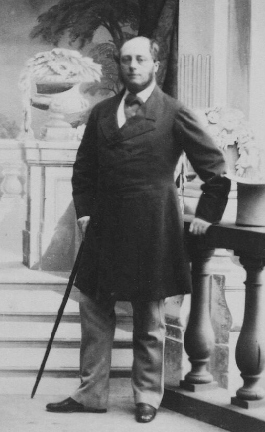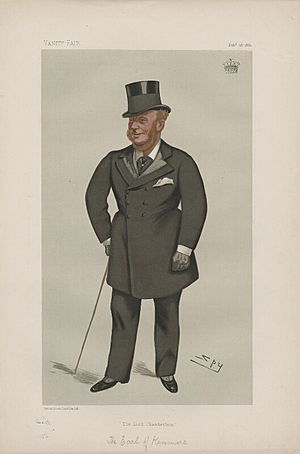Valentine Browne, 4th Earl of Kenmare facts for kids
Quick facts for kids
The Earl of Kenmare
|
|
|---|---|

Browne in 1860
|
|
| Lord Chamberlain of the Household | |
| In office 3 May 1880 – 9 June 1885 |
|
| Monarch | Victoria |
| Prime Minister | William Gladstone |
| Preceded by | The Earl of Mount Edgcumbe |
| Succeeded by | The Earl of Lathom |
| In office 10 February 1886 – 20 July 1886 |
|
| Monarch | Victoria |
| Prime Minister | William Gladstone |
| Preceded by | The Earl of Lathom |
| Succeeded by | The Earl of Lathom |
| Personal details | |
| Born | 16 May 1825 |
| Died | 9 February 1905 (aged 79) |
| Nationality | British |
| Political party | Liberal |
| Spouse | Gertrude Thynne (d. 1913) |
Colonel Valentine Augustus Browne, 4th Earl of Kenmare (born May 16, 1825 – died February 9, 1905) was an important British politician. He was also known as Viscount Castlerosse from 1853 to 1871. He worked in many government roles between 1856 and 1886. One of his most important jobs was Lord Chamberlain of the Household under Prime Minister William Gladstone.
Contents
Who Was Valentine Browne?
Valentine Browne was the son of Thomas Browne, the 3rd Earl of Kenmare. When his father became the Earl in 1853, Valentine was given the special title of Viscount Castlerosse. This is called a courtesy title because it's used by the son of a noble, but it's not his main official title yet.
His family owned a very large amount of land, over 117,000 acres, mostly in County Kerry, Ireland. This land was known as the Kenmare estate.
Building Killarney House
In 1872, the 4th Earl of Kenmare decided to build a brand new house. It was called Killarney House and was designed in a style popular during the time of Queen Elizabeth I. This new house was built on a hill with amazing views of Lough Leane. It cost a lot of money, more than £100,000! Killarney House replaced the older family home, Kenmare House, which was built in 1726 and then taken down.
His Important Government Roles
In 1851, before he became an Earl, Valentine Browne was chosen as the High Sheriff of Kerry. This was an important local role. The next year, he was elected to the parliament to represent Kerry.
In 1856, he got a job in the government as Comptroller of the Household under Prime Minister Lord Palmerston. He kept this job until 1858.
Working for the Queen
In 1857, he became a member of the Privy Council. This is a group of important advisors to the King or Queen. When Lord Palmerston became Prime Minister again in 1859, Valentine Browne became Vice-Chamberlain of the Household. He stayed in this role until 1866. He also held this job again in 1868 when William Gladstone became Prime Minister.
In 1871, his father passed away, and Valentine became the 4th Earl of Kenmare. This meant he could now join the House of Lords, which is part of the UK parliament. He then left his job as Vice-Chamberlain because that role was usually for someone who wasn't a noble. In 1872, he became a Lord-in-waiting, which meant he helped the government in the House of Lords. That same year, he was made a Knight of the Order of St Patrick, a special honor.
When Gladstone became Prime Minister again in 1880, Lord Kenmare was given the very important job of Lord Chamberlain of the Household. He held this position until 1885 and then again for a short time in 1886.
Besides his work in parliament, he was also the Lord-Lieutenant of Kerry from 1866 until he died in 1905. This was a representative of the King or Queen in the county. He was also an Honorary Colonel for the local army group, the Kerry Militia.
His Family Life
Lord Kenmare married Gertrude Thynne in 1858. She was the daughter of Reverend Lord Charles Thynne. They had three children together:
- Lady Margaret Theodora May Catherine Browne (died 1940)
- Valentine Charles Browne, 5th Earl of Kenmare (1860–1941)
- Hon. Cecil Augustine Browne (1864–1887)
Later Years and Legacy
Lord Kenmare passed away on February 9, 1905, when he was 79 years old. His oldest son, Valentine, became the 5th Earl of Kenmare. His wife, the Countess of Kenmare, died a few years later in 1913.


